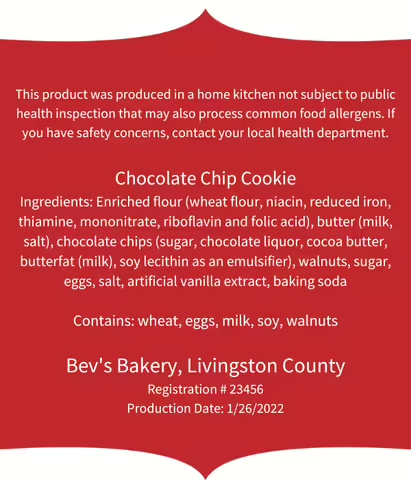Food Labeling and Placards
Follow these food labeling requirements.
Booth placard
At the point of sale a placard is displayed in a prominent location that states the following:
"This product was produced in a home kitchen not subject to public health inspection that may also process common food allergens.”
Online, the notice should be a message on the cottage food operation’s online sales interface at the point of sale.
Food Label
The food packaging must conform to the labeling requirements of the Illinois Food, Drug and Cosmetic Act. The cottage food product must be prepackaged and affixed with a label that includes all of the following information:
Required Information
- The name of the cottage food operation and unit of local government (county, township, city, or village ) in which the cottage food operation is located.
- The identifying registration number provided by the local health department on the certificate of registration and the name of the municipality or county in which the registration was filed.
- The common or usual name of the food product.
- All ingredients of the food product, including any color, artificial flavor, and preservative, listed in descending order by predominance of weight shown with the common or usual names.
- The following phrase in prominent lettering: “This product was produced in a home kitchen not inspected by a health department that may also process common food allergens. If you have safety concerns, contact your local health department.”
- The date the product was processed or prepared.
- Allergen labeling as specified under federal labeling requirements.
Request for a Labeling Exemption: Some products may be difficult to properly label or package, such as a wedding cake. In this case, the cottage food operator should contact the local health department of the location where the product is sold to seek special permission. If an exemption is granted, the cottage food producer must include all labeling requirements on a receipt or similar document that is delivered to the customer with the product. The request for a labeling exemption is on the cottage food registration form. Simply check the box, list the products for which you are requesting an exemption and provide a rationale.
Voluntary Information
A cottage food operator may include the designation “Illinois-grown,” “Illinois-sourced,” or “Illinois farm product” if the packaged product is a local farm or food product, as stated in Section 5 of the Local Food, Farms, and Jobs Act. Local farm or food products are products:
- grown in Illinois; or
- processed and packaged in Illinois, using at least one ingredient grown in Illinois.
Check out this example of a label:
This product was produced in a home kitchen not subject to public health inspection that may also process common food allergens. If you have safety concerns, contact your local health department.
- Chocolate Chip Cookie
- Net Wt. 3 oz (85.05 g)
- Ingredients: Enriched flour (Wheat flour, niacin, reduced iron, thiamine, mononitrate, riboflavin and folic acid), butter (milk, salt), chocolate chips (sugar, chocolate liquor, cocoa butter, butterfat, (milk), Soy lecithin as an emulsifier), walnuts, sugar, eggs, salt, artificial vanilla extract, baking soda
- Contains: wheat, eggs, milk, soy, walnuts
- Prairie Cottage Food, Sunshine County
- Registration Number: 12345, Sunshine County
- Production Date: 4/19/2022
Allergen Labeling as Specified in Federal Labeling Requirements
A cottage food operation label must identify if any of the ingredients are made from one of the following food groups:
- milk
- eggs
- wheat
- peanuts
- soybeans
- fish
- crustacean/shellfish
- tree nuts (identify which nut: i.e., almonds)
- any ingredient made from these food groups
For example: If the cottage food operation is making whole wheat bread, they have the following two options:
- Include the allergen in the ingredient list. For example, a whole wheat bread with the following ingredient listings: whole wheat flour, water, salt and yeast. In this example, the statement “Whole wheat flour” is the allergen and this statement meets the requirements of federal law.
- Include an allergen statement (“Contains.”) after the ingredient list. For example, a whole wheat bread with the following ingredients: Whole wheat flour, water, sodium caseinate, salt and yeast. Contains: wheat and milk. The “contains” statement must include all the allergens found in the product.
